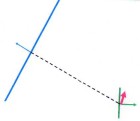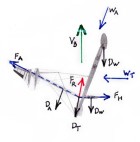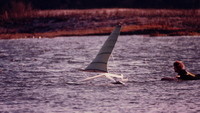High-Speed Sailing
| Vessel Name: | Sailien |
| Vessel Make/Model: | Experimental/custom |
28 September 2013
The America’s Cup
I watched, with interest, the videos of the 34th America’s Cup. At last we have fast sailboats engaged in a competition that is fun to watch. The virtual images (such as course boundaries, distance grid lines, separation between boats, etc.) overlaid on the real images really helps to keep the race [...]
31 August 2013
100 Knots for Hydroptere?
The latest news from Hydroptere is that they have plans for a 100 knot sailboat. This was posted on 26 Aug 2013, so look for that date at this address. http://hydroptere.com/en/the-news/last-news/
17 November 2012
Aptly named Sailrocket, blasts off!
While yet to be ratified, Sailrocket posted an average speed over 500 meters of 59 knots. I will not be surprised if they increase their record into the 60 knot range during this record attempt.
02 January 2012
More drag for VSR2?
I want to start by pointing out that the whole VSR2 team has done a stellar job and has demonstrated conclusively that the forces that drive a sailboat can be aligned for roll stability without using ballast and without using any down-force. (Trifoiler achieved roll stability by using down-force, but [...]
18 December 2011
My analysis of Sailrocket
I copied a diagram of VSR2 (wing doesn’t show well) and added in the major force arrows that apply. Be aware that these arrows are not correct in terms of scale (length) and some of their locations are guesses, however I believe I’m correct enough for us to learn something about what VSR2 has been [...]
23 October 2011
60 is within reach, what’s next?
I have been watching Sailrocket’s progress with great interest and there’s no question they have a winner. I fully expect to see them reach 60kt in the near future. Sailrocket has now demonstrated what I first learned with my models and again with my full-sized prototypes, that if you get the forces [...]
A comment on Bernard Smith
The most important concept that Smith taught is that by proper positioning of the airfoil (sail) with respect to the leeway resisting hydrofoil (keel, centerboard, etc) the forces that drive the boat could be brought into alignment; properly done, this results in a craft that the wind cannot heel or flip. This is a major advance in the evolution of sailboat design, and I'm certain it will become the design standard. Smith used the analogy of a kite towing the boat in discussing this concept, and today kite-boarding is big.
A look at Smith's sailboat patents shows an interesting progression as he designs toward a 40-knot sailboat. His first patent (1963) shows a design that still needs weight to balance it. In his next (1967) he no longer needs weight for balance but his windward foils are vertical and would get overpowered in high wind situations, the craft would be stable but speed would be limited. His next patent (1972) corrects this with curved windward hydrofoils. Skipping the next two patents (hardware & design variations) we come to his 1980 patent. In this, Smith takes a huge step backwards in terms of fast sailboat design. He puts the leeway resisting (steering foils) to leeward; this eliminates roll (overturning) stability and violates what I said above to be the most important point Smith taught.
I'm not criticizing Smith for doing so; I'm just trying to convey an understanding of some key points that have to be understood if you want to achieve roll stability optimally. I suspect Smith did this in an attempt to improve low wind-speed performance.
Following Smith, we have Ned Snead, who designed a variation on Smith's 1980 patent, in which he used three slender hulls that were all steer-able. This again put leeway resistance to leeward which destabilizes the craft in high wind conditions. A version of this craft was built and sailed in a speed competition. Well they got a good breeze and managed to put on a good show with a spectacular flip. Go to the address below for more info. I would like to get a clip of the video from that run if any of you know how.
http://www.geocities.com/aerohydro/othercraftframeset.htm
I have been told that "An inclined rig is inherently unstable." (I had already proven otherwise when I first heard this.) I do not know where that statement originated or who first said it, but it's false and will cramp your thinking. The flip of Ned Snead's craft may have contributed to that idea.
Sailrocket appears to have its origins with Ned Snead, but I'll have to chat with designer Malcolm Barnsley to find out more.
Bob
About & Links
- Bob's Surfing Blog
- Bob's Website
- Greenbird (Windjet)
- l'Hydroptere
- Le Projet Dared
- Macquarie Speed Sailing Team
- Monofoil Sailing
- Mountain Goat STOL
- Mr Smith's Amazing Sailboats
- Patent Office (Search)
- Radboat
- Sailien Prototypes (early), Delta, etc.
- Sailien Video
- Sailien Website
- The Basics of Surfboard Design
- The Basics of Surfboard Design en Espanol
- The Swedish Speed-Sailing Challenge
- Trifoiler
- Vestas Sailrocket
- Windjet Project
- WSSRC


